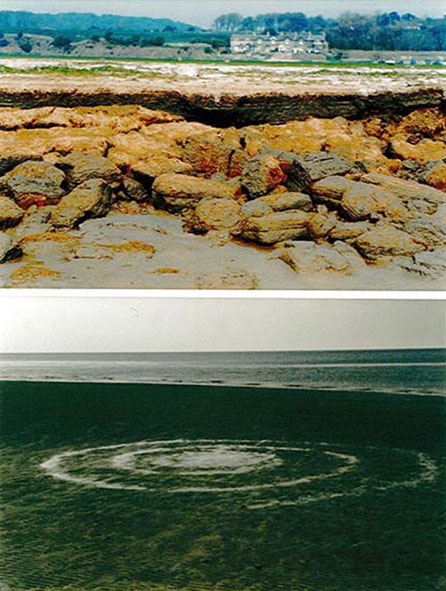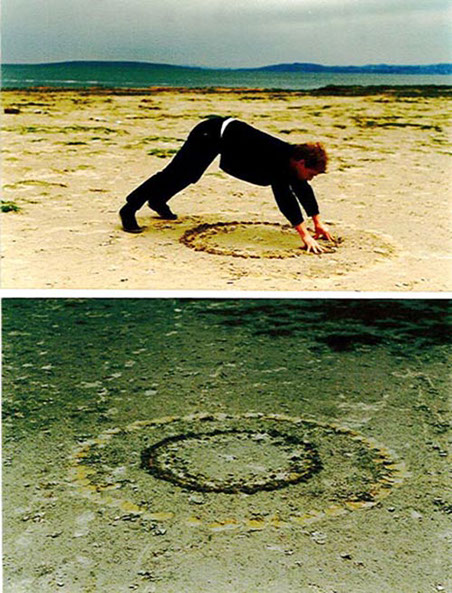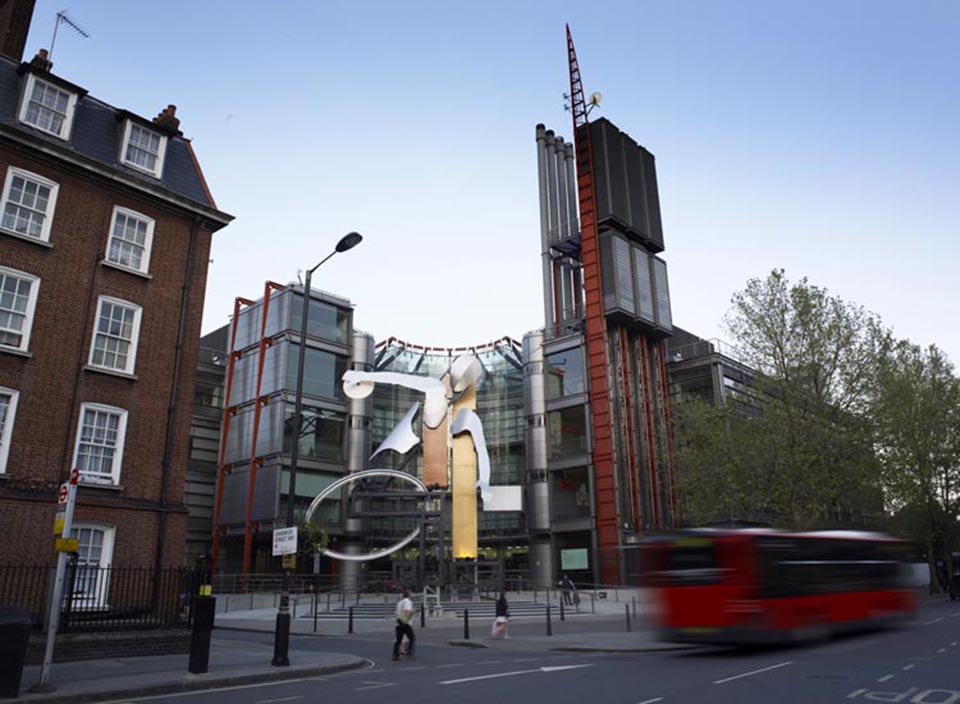

GOLD LAMÉ
Liverpool Plinth 2018 - 2019
Material: Fibreglass, steel, automotive paint.
Dimensions: L. 9’9” W. 4’6”
Date: 2014
Gold Lamé will hover above the roof of Liverpool Parish Church, also known as St Nick’s overlooking Chapel Street, the waterfront and Liver Building for the next 12 months. It is the first sculpture to occupy the plinth following a collaboration between Liverpool BID Company and Liverpool Parish Church who commissioned city gallery and art organisation, dot-art, to showcase sculptors in the north.

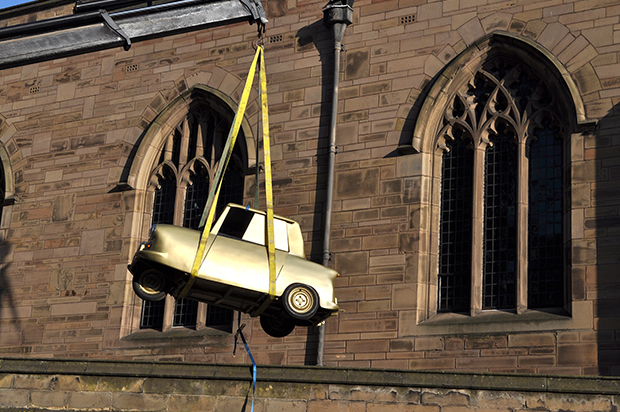
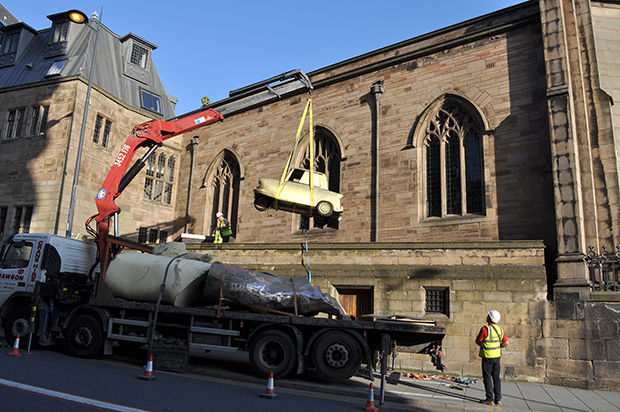
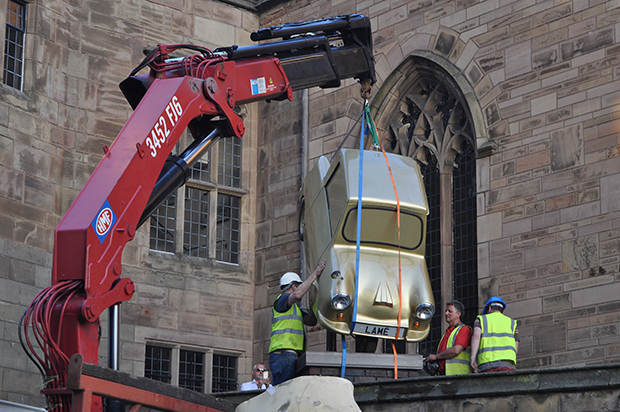
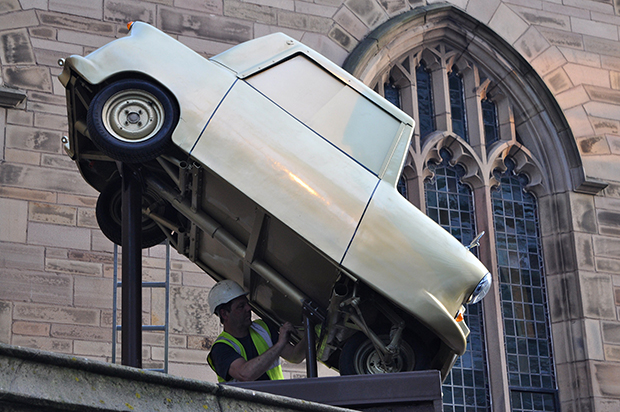

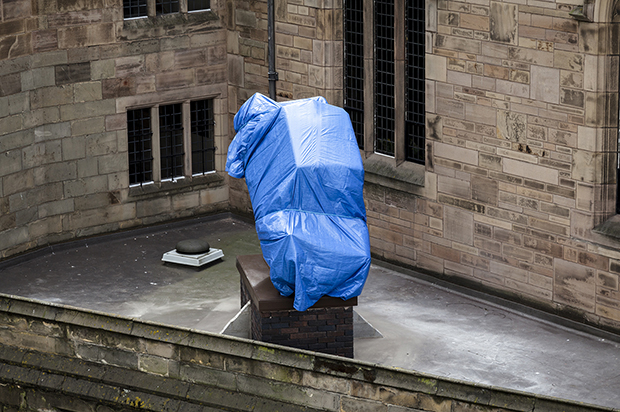




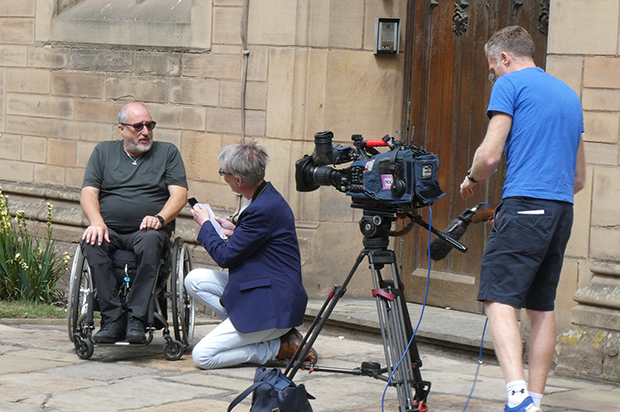
Installation Pic: Cintia Prieto
Installation Pic: Cintia Prieto
Installation Pic: Cintia Prieto
Installation Pic: Cintia Prieto
Installation Pic: Cintia Prieto
Installation Pic: Cintia Prieto
Pre-unveiling Pic: Robin Utracik
Pre-unveiling Pic: Robin Utracik
Unveiling Pic: Peter Byrne/PA Wire
Unveiling Pic: Peter Byrne/PA Wire
Press interview Pic: Robin Utracik
Press interview Pic: Robin Utracik
<
>
Bill Addy, chief executive of
Liverpool BID Company, said:
"Gold Lamé certainly grabs the eye but carries an important message as well. We are sure it will be a welcome new addition to the area and enjoyed by businesses, residents and visitors over the coming year."
Lucy Byrne, managing director
of dot-art, said:
"We set out to give established and up-and-coming sculptors in the north a unique opportunity to showcase their works at one of Liverpool's most iconic buildings. We were inundated with some fantastic submissions, but it was Tony Heaton's Gold Lamé that really struck a chord. Dazzling, humorous, and equally meaningful, like all great art, Gold Lamé will spark conversation and put a smile on people's faces."
The Reverend Dr. Crispin Pailing,
rector of Liverpool, added:
We are over the moon that a thrilling piece of new art has found a new home in one of the most beautiful areas of the city. Visitors to the area will hopefully engage and feel inspired by this new sculpture."
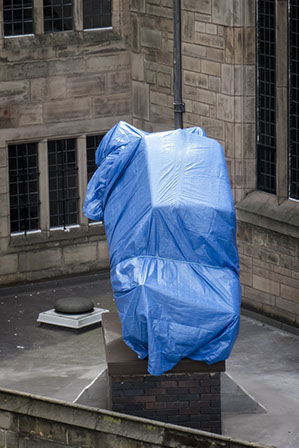
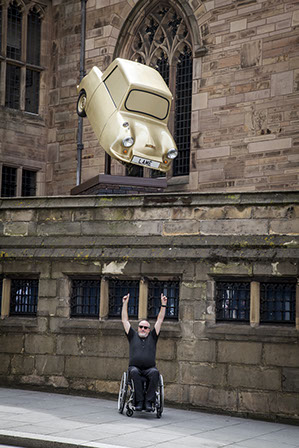
Unveiling the Plinth, video by Paul Frost
*for more information on Gold Lamé see below....
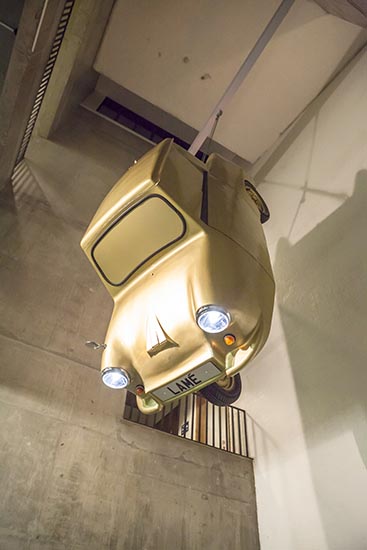
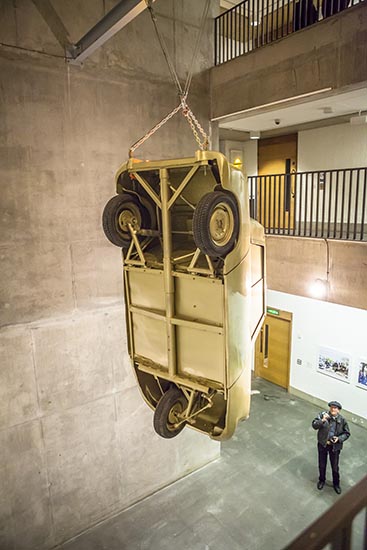
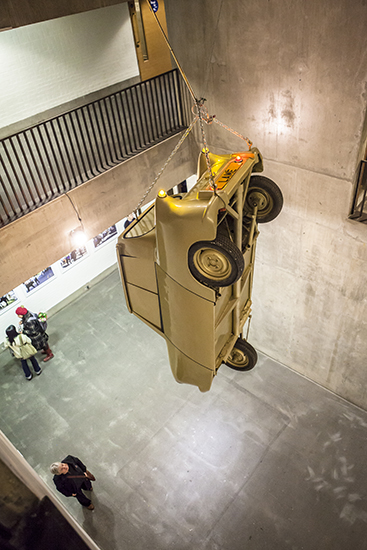
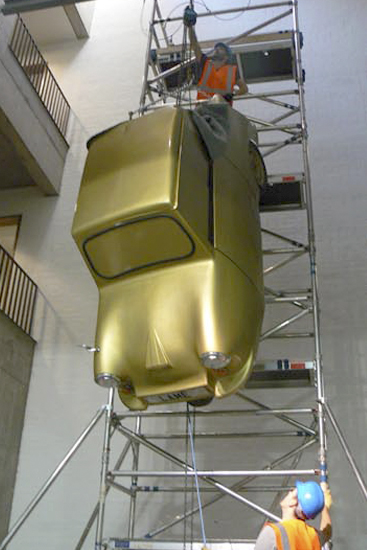
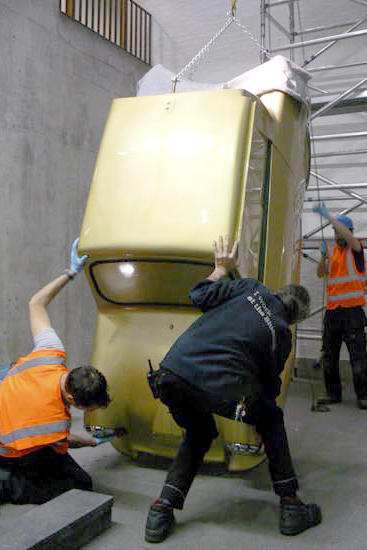
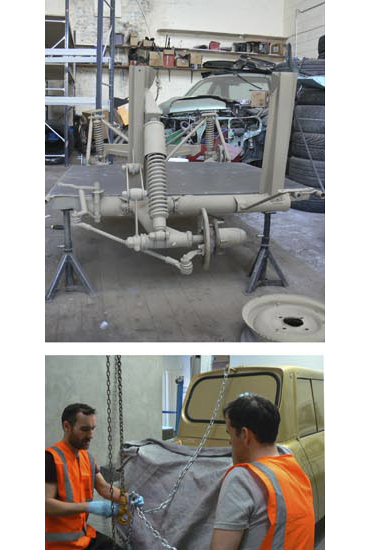
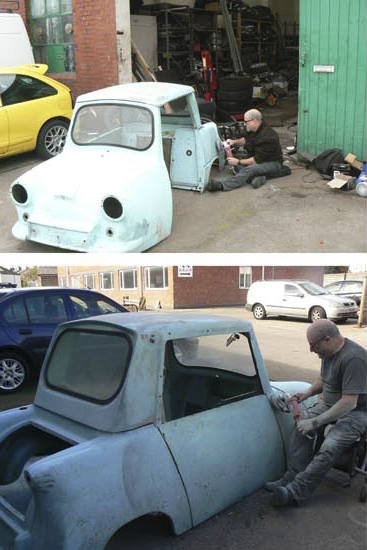
3 - 7
<
>
GOLD LAMÉ
Material: Fibreglass, steel, automotive paint.
Dimensions: L. 9’9” W. 4’6”
Date: 2014
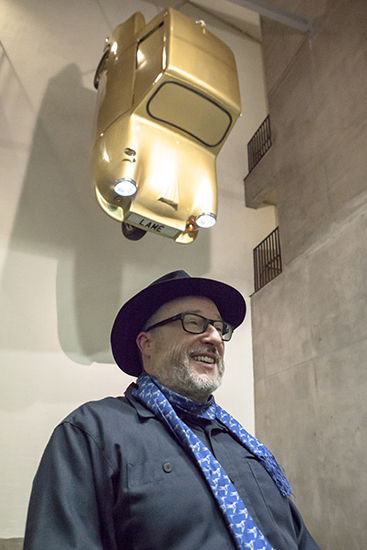
This sculpture began, as many do, with a conversation.
This particular conversation was with the Curator of the ‘Art of the Lived Experiment’, Aaron Williamson, concerning alchemy, the idea of turning a base metal into gold, turning something of little value into a substance of value, a speculative philosophy. The objective of alchemy, the quest for transmutation, was often primarily aimed at effecting personal change in the Alchemist.
The changing of objects and meaning has been constant within my practice as an artist, and, for this current work and response to the idea of ‘the art of the lived experiment’ I have selected an iconic object, the Invacar, and the notion of transmutation, the effecting of personal change.
Its complicated, I transmuted from Biker to Invalid.
I was issued with an Invacar in 1971.
The Invacar was a societal response, initiated by government, to the lack of access to so-called public transport. The solution was to provide Invalids with a form of very cheap transport, though considered a prosthetic, a medical replacement for legs.
An unlined fiberglass shell, 9’.9” long and 4’.6” wide, a single seat, sat on a chassis of three wheels, space for a folding wheelchair, propelled by a small motorcycle engine with a cubic capacity of 197, three gears plus reverse and a maximum speed of around 45 mph. The single seat meant that you travelled alone, the assumption had to be that you had no friends, family, lovers, the solitary cripple, other.
They were all painted the same colour, to mark you out as other. A pale blue, NHS Blue, this became know as Spazz Blue.
It was banned from motorways. This was clearly stated on all motorway signage. No Invalid Carriages. It disappeared from the roads of Britain in 1983, and like all icons can now only be witnessed, restored pristine, in the museum.
But this one escaped, suspended, transformed from prosthetic to sculpture, transmuted from Spazz Blue to Gold, Lame to Lamé.
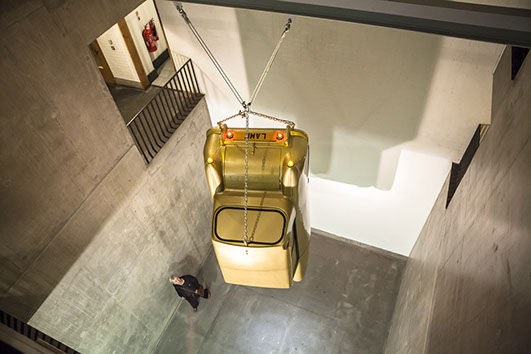
SUSAN (ZENGIRLS)
Material: Bronze cast - Artist edition of 5
Dimensions: L. 305mm W. 305mm H.235mm
Date: 2020
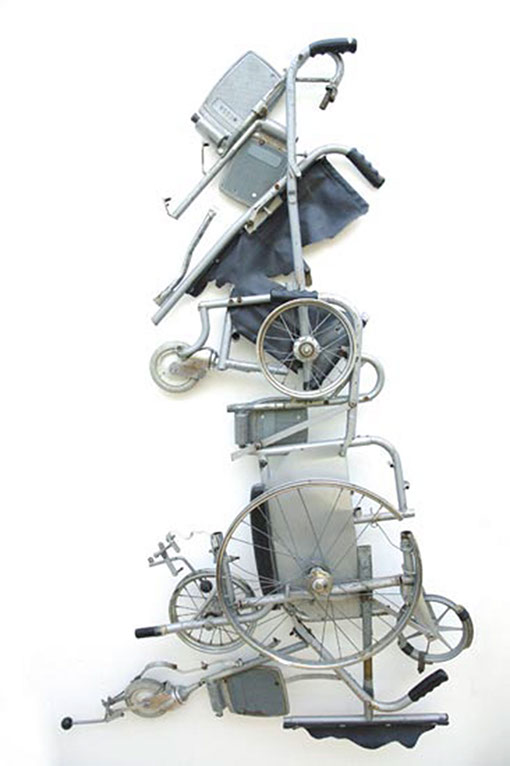
GREAT BRITAIN FROM A WHEELCHAIR
'Great Britain from a Wheelchair' is a map of Britain made from parts of two grey NHS wheelchairs. When Tony first told me about this work as he was making it, it seemed a rather foolish and unworkable idea. I was wrong: it's wonderful - I described it elsewhere as 'like a disability version of one of my very favourite art works, the bull's head which Pablo Picasso made from a bicycle saddle and handlebars.' First seeing it, in the 'Unleashed' exhibition earlier this year, I found that initially it just looked like a lot of bits of old wheelchairs. As with those 3D prints, it took a while to adjust perceptually. Then suddenly it sprang into place - a complete, startlingly real map of Great Britain.
A delightful game, it forms a wonderful repudiation of the value judgement ('This is for some tragic bastard', in Tony's words) implicit in the wheelchairs.
Allan Sutherland (edited from DAIL magazine)
A simple, visual pun, constructed from two ex-ministry Vessa Wheelchairs.The experience of Great Britain from a Wheelchair is somewhat different.
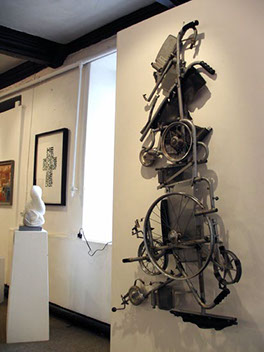
"This a bold representation of Channel 4’s commitment to changing attitudes to disability with our coverage of the London 2012 Paralympic Games.”
Channel 4’s Chief Executive David Abraham
MONUMENT TO THE UNINTENDED PERFORMER
Channel 4’s Chief Executive David Abraham today unveiled the latest installation on the ‘Big 4’ outside the corporation’s Horseferry Road headquarters – the design of which celebrates Channel 4’s involvement and commitment to the London 2012 Paralympic Games.
The installation, Monument to the Unintended Performer, is by disabled sculptor and artist Tony Heaton. The piece brings together three elements in addition to the Big 4: the first based on the classical Greek sculpture Discobulus, the discus thrower, evoking the spirit of the Olympics; the second element, a circle, representing the wheel of the international symbol of access; and lastly, the introduction of gold, silver and bronze considers hierarchy.
The latest installation on the Big 4 was unveiled as Channel 4 launched its coverage of the 2012 Paralympic Games at an event attended by Lord Sebastian Coe, Chairman of LOCOG.
Tony Heaton said: “I wanted to use the structure of the Big 4 as one of four elements that would fuse together to form a new cohesive piece – which would provoke thought and celebrate Channel 4’s involvement and commitment to the Paralympics. The subtext of the piece is the assertion that disabled people are almost always the object of scrutiny and curiosity.”
David Abraham said: This new installation by Tony Heaton is a striking addition to the iconic Big 4 and is a bold representation of Channel 4’s commitment to changing attitudes to disability with our coverage of the London 2012 Paralympic Games.”
Tony Heaton has worked as a sculptor since the inception of what became known as disability arts, a movement inextricably linked to the politics of disability. His performance piece ‘Shaken not Stirred’ – created from the stacking into a pyramid of 1,760 red charity collecting tins and then destroyed by the hurling into it of a prosthetic leg with a steel toe capped boot for the ‘Block Telethon’ campaign – was part of a seminal moment where disabled activists protested against the televising of Telethon and demanded rights not charity. Similarly, the assemblage, ‘Great Britain from a Wheelchair’ – a map of Britain constructed solely from the deconstructed parts of two condemned ex-ministry wheelchairs - has become an enduring image of that time.
The 50 foot high Big 4 was built in 2007 to celebrate Channel 4’s 25th anniversary and has previously been customised by acclaimed photographer Nick Knight, Turner Prize Titchner, renowned Ghanaian
sculptor El Anatsui, art graduate and competition winner Stephanie
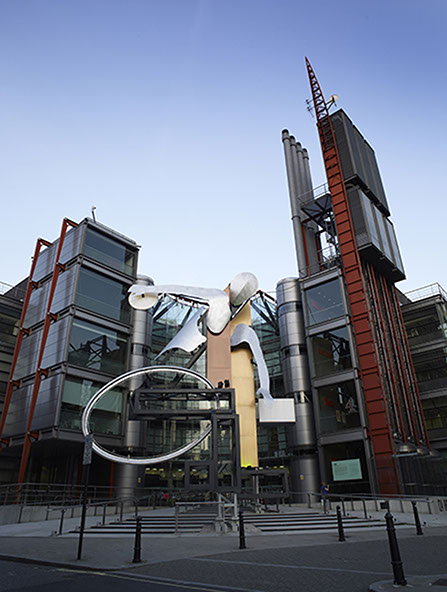
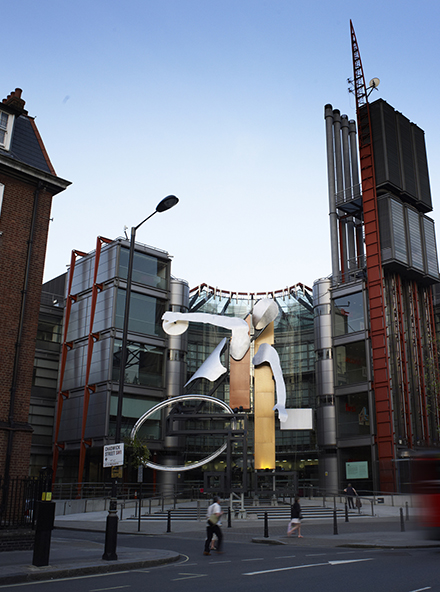
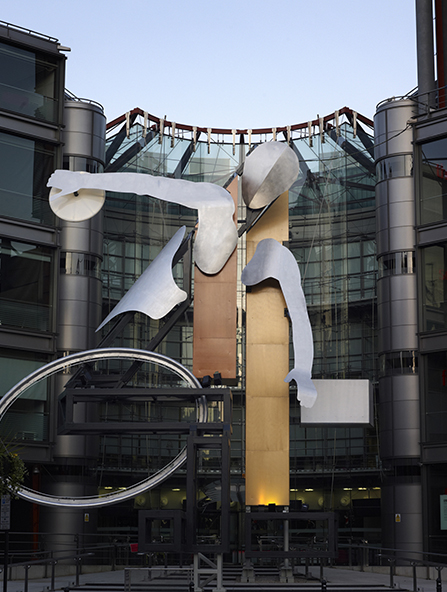
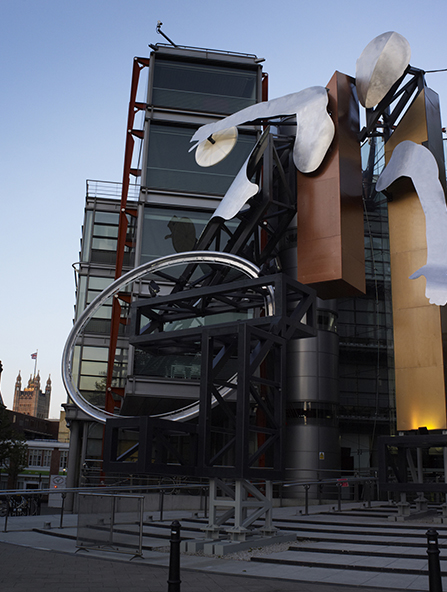
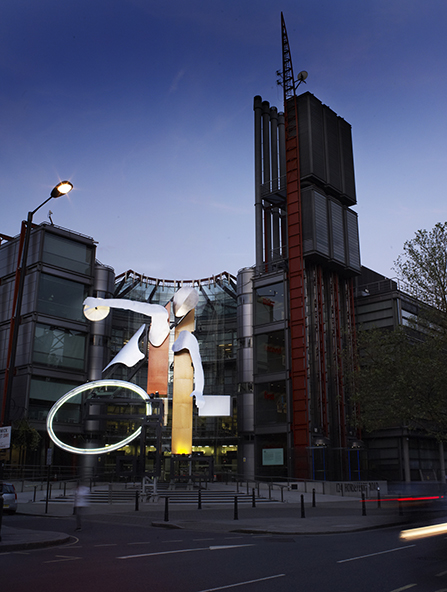
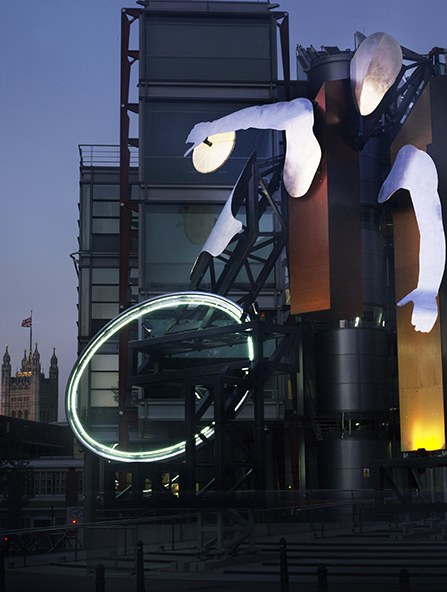
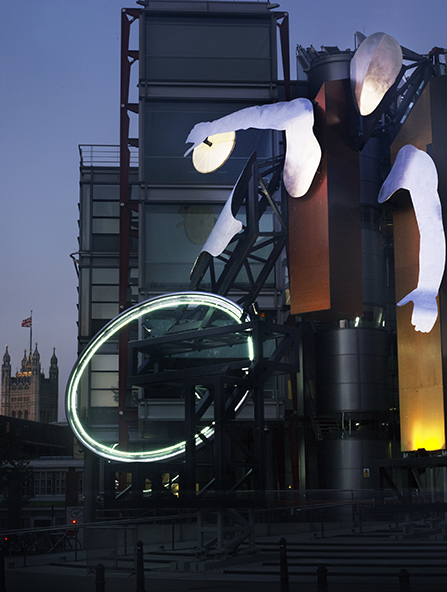
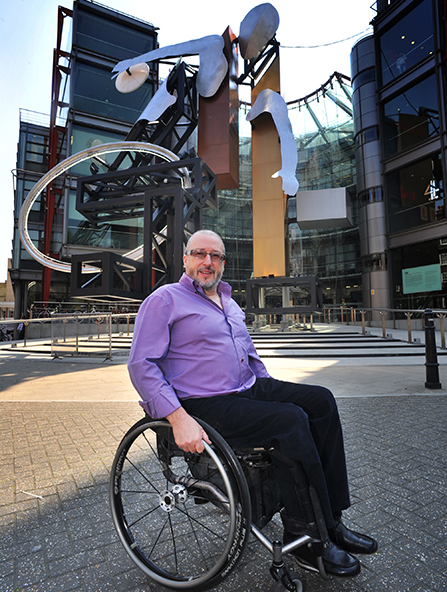
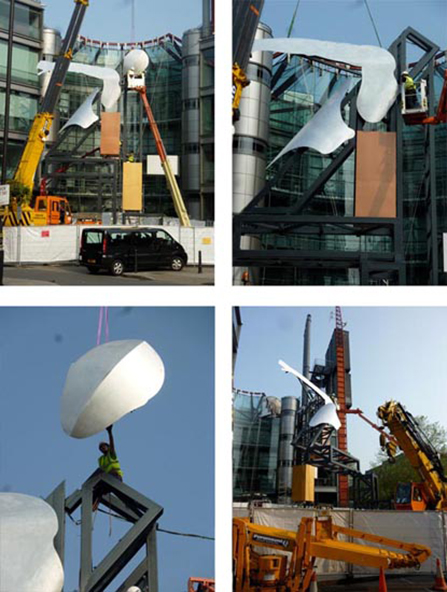
8 - 9
<
>
GREAT BRITAIN FROM A WHEELCHAIR (RE-VISITED)
Sculptured plinths for Lord Coe and Sir Phillip Craven, commissioned by LOCOG for the 2012 Olympic and Paralympic Games.
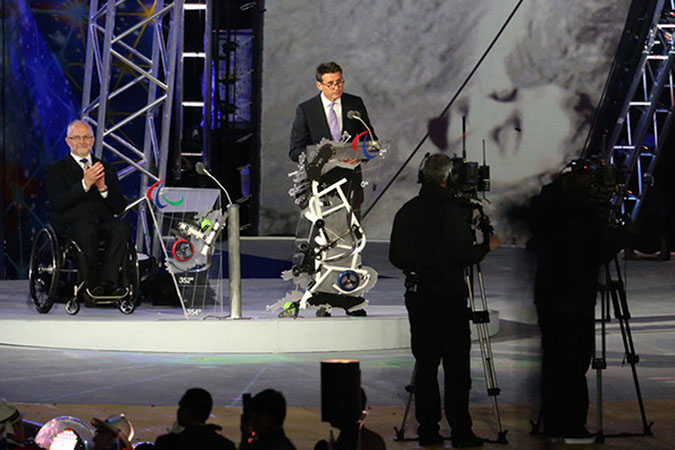
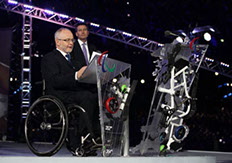
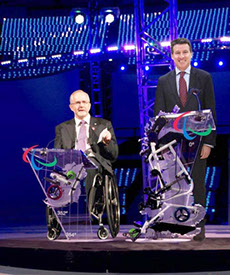
GREYMARES
Greymares was the result of winning a public art competition run by Community Arts North West and Manchester City Council, collaborating with a local school who wanted horses reflected in the work. The work is sited at Greymares Lane in Beswick, Greater Manchester. Research showed that the area was once a common and popular resting point for gypsies. I developed the sculpture to reflect horses and fairgrounds by depicting Gallopers, one of the traditional fairground rides. These gallopers were cut from stainless steel plate by laser water jet technology at Barrow in Furness shipyard. The two metre long horses were prefabricated at Kendal with a central ball bearing race seated in a rubberised housing which allows the sculpture to rotate like a weather vane. The sculpture sits on top of a 25 foot brick column. A blue glazed brick spirals around the column, suggesting movement. A seat running around the base of the column invites people to use the sculpture as a meeting place.
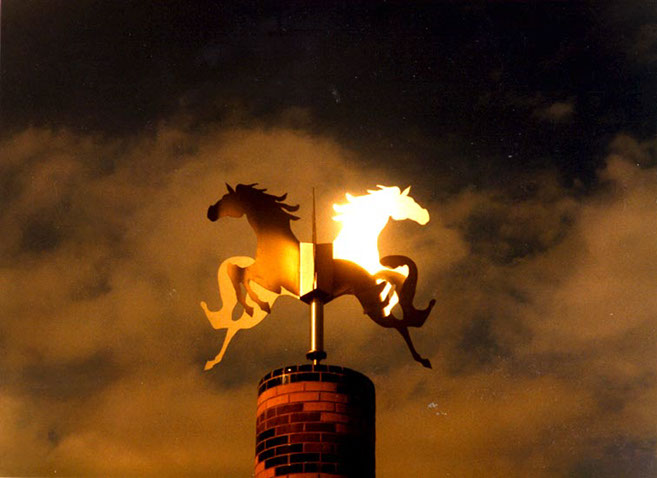
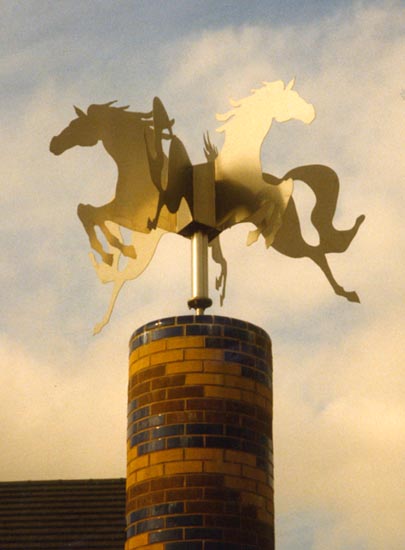
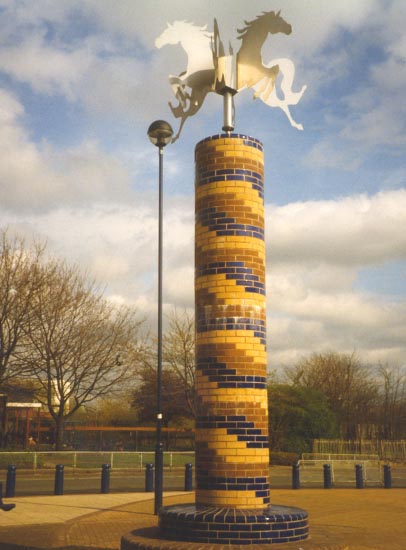
REARRANGED PENIS
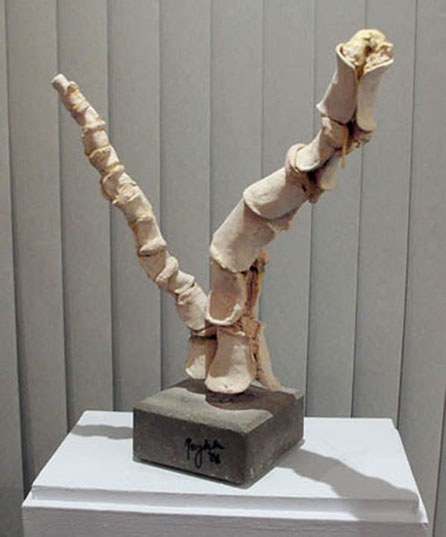
The sculpture is constructed from individual vertebrae made from porcelain, fired and then connected by pouring paper clay and re-firing.
Did you sleep with the fates?
Did they ride pillion with you that night?
Did those three goddesses
Possess you and do they now control your destiny?
Perhaps so, for it seems to me that it is more than
Irony that presides here.
There seems a predestined inevitability,
Predetermined power principles
That have dictated your consequence
Of being born to be wild.
The price you now pay back
By instalments. Piece by piece.
The latest gift you brought as promised
Carries with it a certain realisation
In its creation, that time like the tables
Continue to turn and ultimately the numbers
Do come around again.
A reminder that life is equally extraordinary,
Beautiful and brutal. Life is the real deal,
And needs to be gambled.
It sits in the alcove in the space
In which you envisaged it
A niche of measured proportions
That would frame your rachis.
Cock sure that this construction
Would fit.
Certain that you could manipulate
Its primary and secondary intent.
But then it happened. As before.
Shattered in transit - the penalty
For being experimental
For daring to move your form at speed
Without due care; without sufficient
Prophylaxis.
And so the table turned
And so the bet was laid
Thus, you both came
Together. Individually unified
As I had expected,
And perversely hoped;
Deranged. In pieces.
Fractured. Rebuilt. Redesigned and
Systematically reassembled.
Rearranged.
Stronger in repair.
More interesting and challenging.
Throwing up questions and enquiry.
Ejaculating a brief pious utterance of prayer.
“It is finished”.
As always my friend you’ve delivered
A wonderful dichotomous.
Produced by timely fate rather than accident
Two erections for the price of one.
Raymond C Bramford
from 'Virginal Blues' poems and prose, 2007
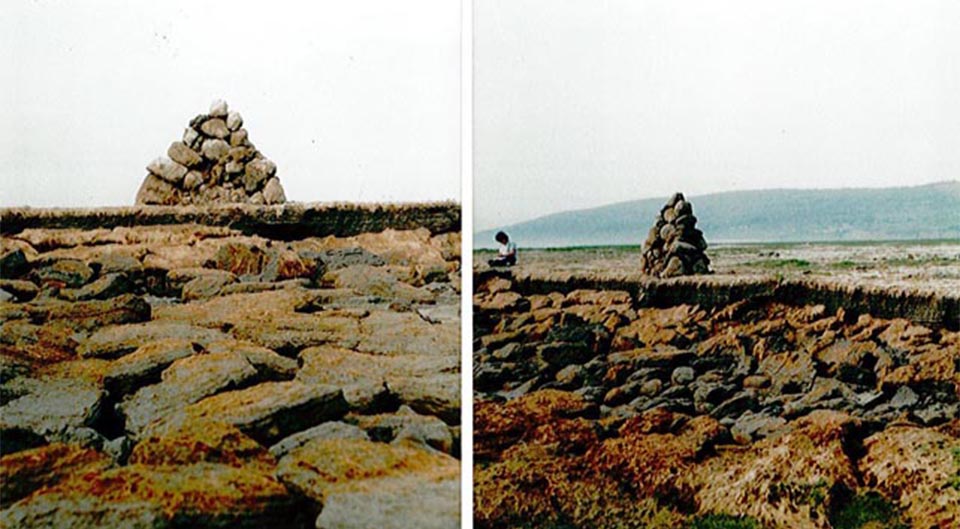
LANDMARKS
1987
A series of land -based ephemeral works made with sculptor Peter Graham on Morecambe Bay in Silverdale, Lancashire.
